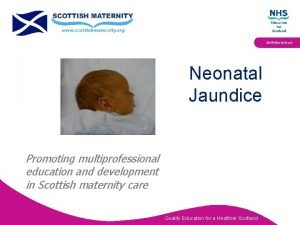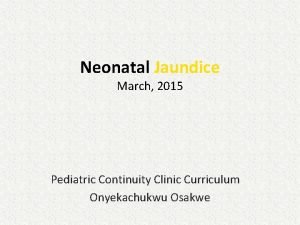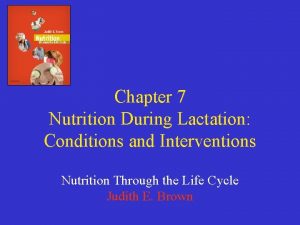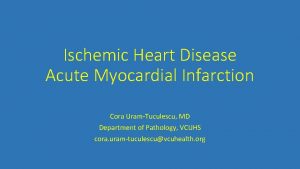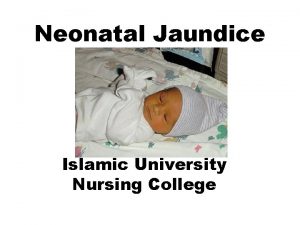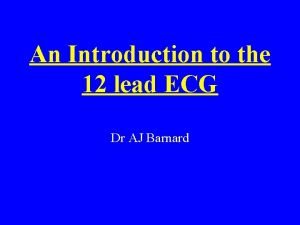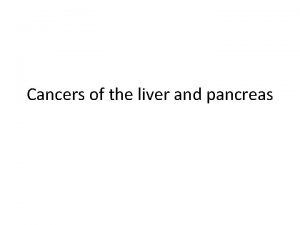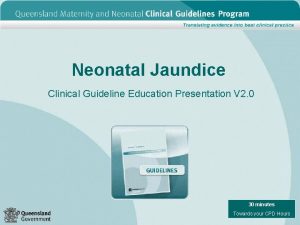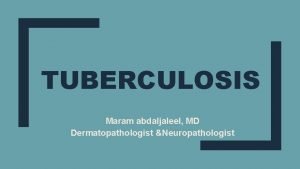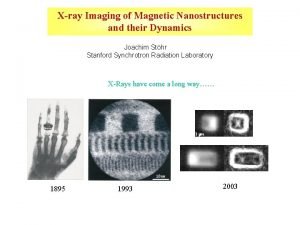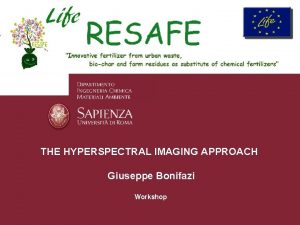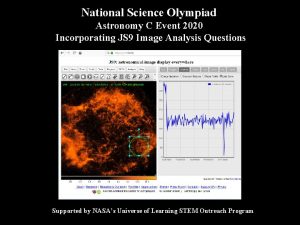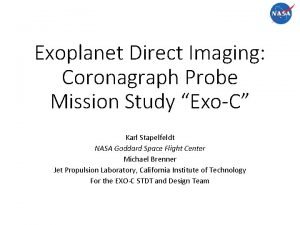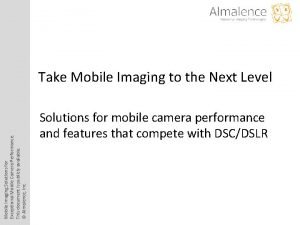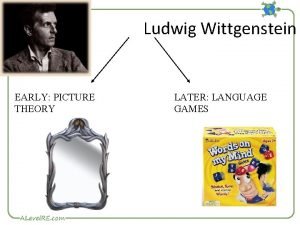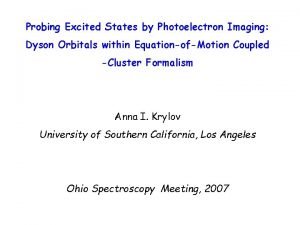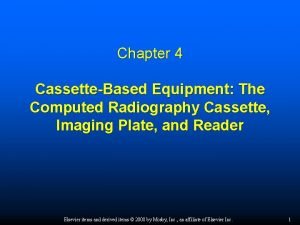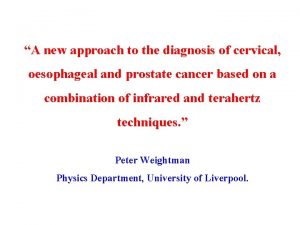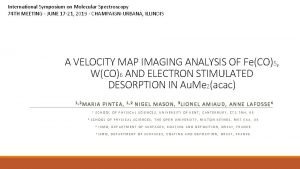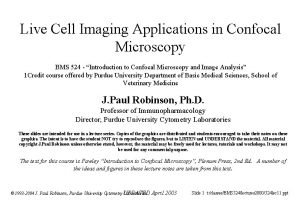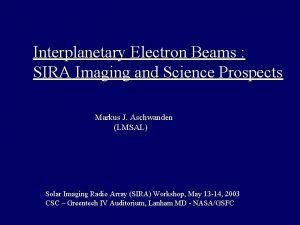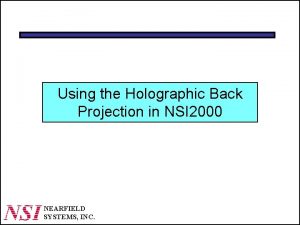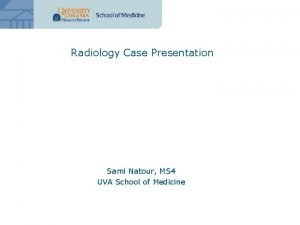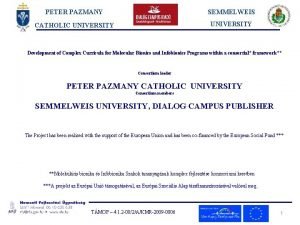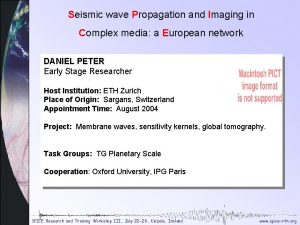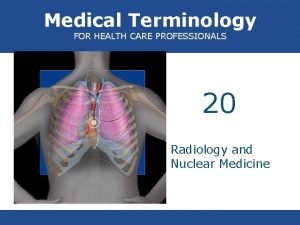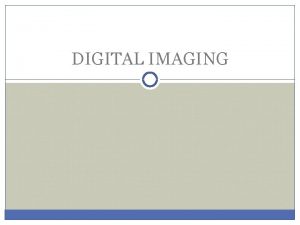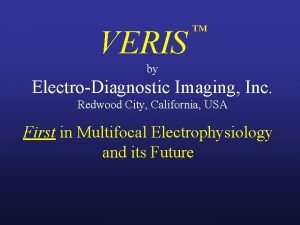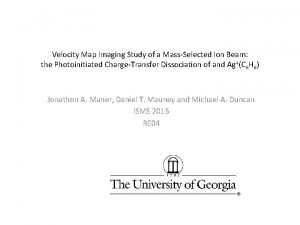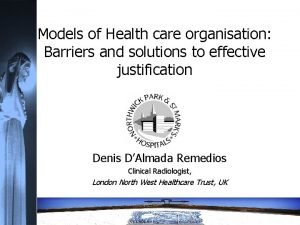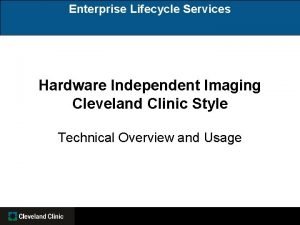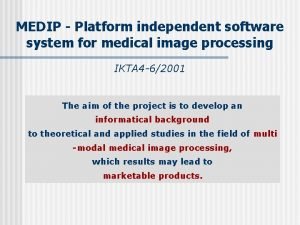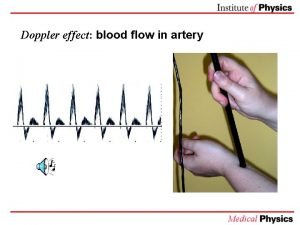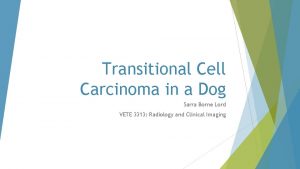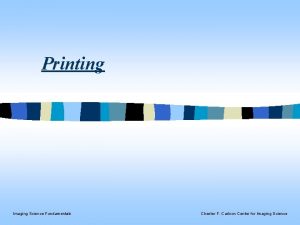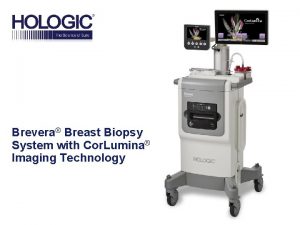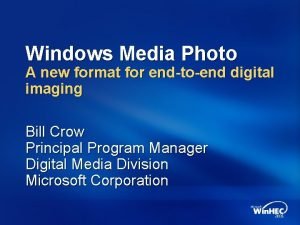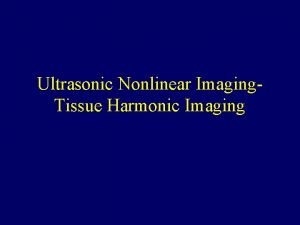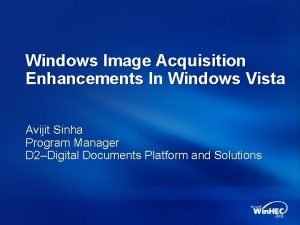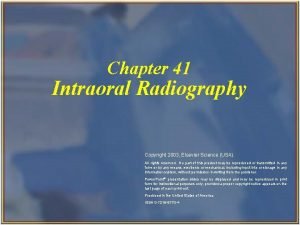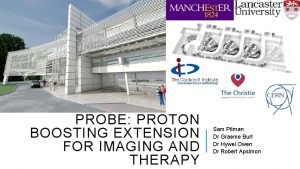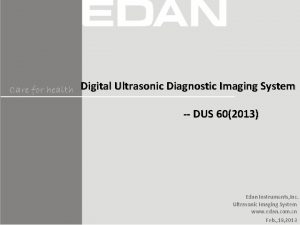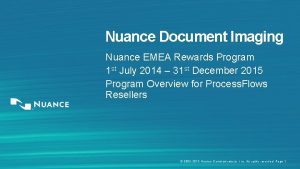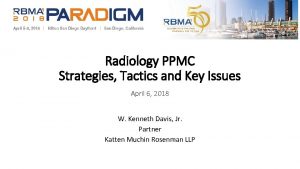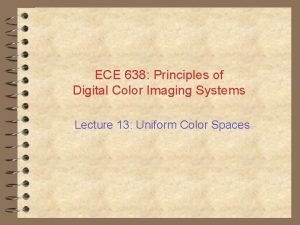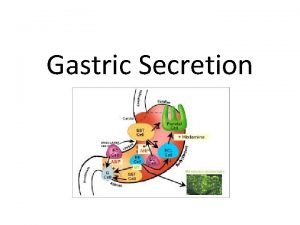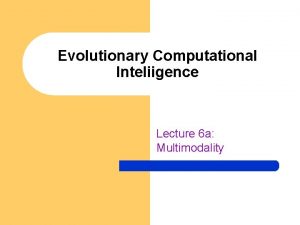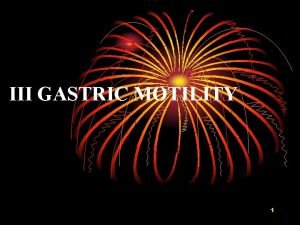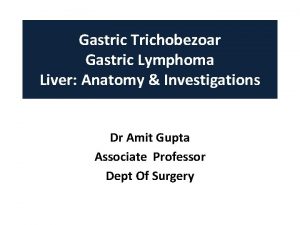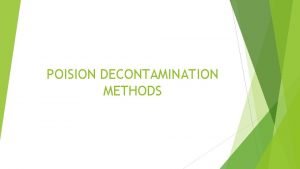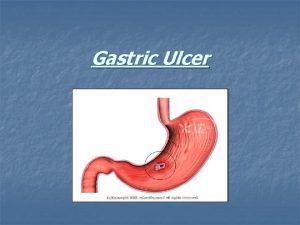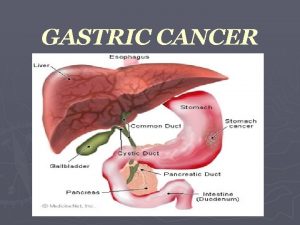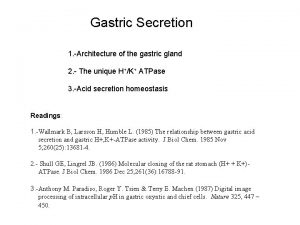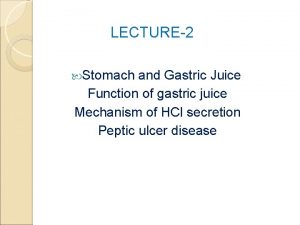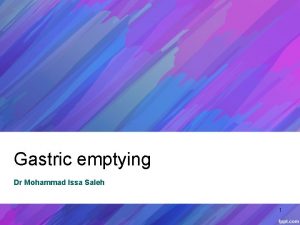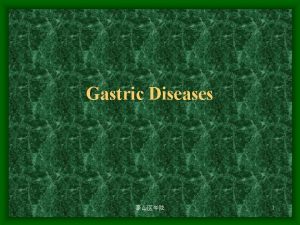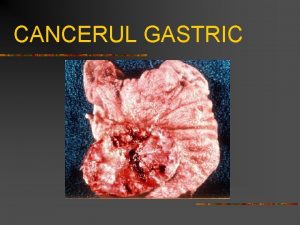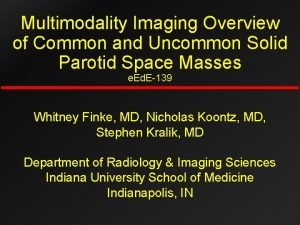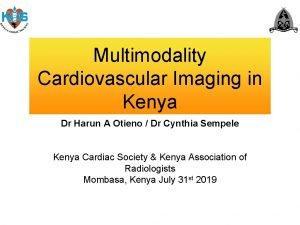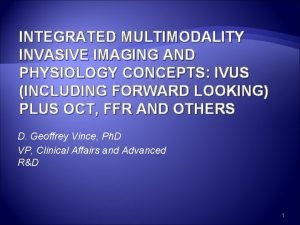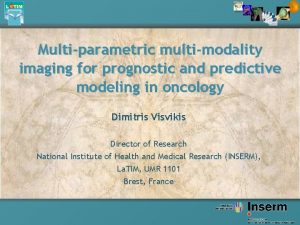Multimodality Imaging of Gastric Pathologic Conditions A Primer





























































- Slides: 61

Multimodality Imaging of Gastric Pathologic Conditions: A Primer for Radiologists Ashley C. Anderson, MD John D. Millet, MD, MHS Matthew S. Manganaro, MD Ashish P. Wasnik, MD

Author Affiliations: Department of Radiology Michigan Medicine, University of Michigan UH B 1 -D 502, 1500 East Medical Center Drive Ann Arbor, MI 48109 Address correspondence to: A. P. W. (email: ashishw@med. umich. edu) Presented as an educational exhibit at RSNA 2018 (GI 190 -ED-X). All authors have disclosed no relevant relationships. Acknowledgments: The authors thank Vanessa Allen and Danielle Dobbs from the UM Radiology Media Division, University of Michigan, for the illustrations and artwork used in this presentation.

Introduction • A wide spectrum of gastric pathologic conditions can be detected and evaluated at imaging. • Radiologists should know the key imaging features of common and uncommon gastric pathologic conditions and understand how to differentiate them at imaging. • Contrast material–enhanced CT and upper gastrointestinal contrast-enhanced fluoroscopy are the primary imaging modalities used by radiologists to evaluate gastric diseases. • MRI, catheter angiography, SPECT/CT, and PET/CT can also provide useful information in specific scenarios. • Esophagogastroduodenoscopy (EGD) remains the standard modality for the definitive diagnosis of most gastric pathologic conditions.

Learning Objectives At the end of this presentation, the reader will be able to: • Identify various non–postsurgical gastric pathologic conditions encountered at imaging, including gastric emergencies. • Stratify gastric pathologic conditions as neoplastic, inflammatory, infectious, or emergent. • Differentiate benign from malignant gastric masses using an imageguided pattern-based algorithmic approach.

Gastric Pathologic Conditions INFLAMMATORY AND INFECTIOUS NEOPLASTIC • • Adenocarcinoma Lymphoma Neuroendocrine tumor Mesenchymal tumors o o o o Gastrointestinal stromal tumor (GIST) Non-GIST sarcoma Lipomatosis Leiomyoma Schwannoma Glomus tumor • Metastasis • • Gastritis Anisakiasis Ménétrier disease Gastric pneumatosis EMERGENCIES • • • Emphysematous gastritis Gastric hemorrhage Bouveret syndrome Gastric rotations and volvulus Bezoars

Diagnostic Imaging Modalities for Gastric Pathologic Conditions Endoscopy and endoscopic US • Standard modality with the ability to perform targeted tissue sampling • Can help identify small gastric ulcers and areas of induration • Can help differentiate mucosal from submucosal and intramural masses Upper gastrointestinal imaging • Adjunct screening modality to endoscopy • Double-contrast imaging: Assess for intraluminal, mucosal, or intramural lesions • Single-contrast imaging: Assess for gastric outlet obstruction Contrast-enhanced CT • Limited role in the initial identification of mucosal pathologic conditions • Preferred modality for the staging of malignant gastric masses • Oral contrast material: Neutral or negative oral contrast material (water, 0. 1% barium sulphate suspension) can aid in the detection of mucosal and submucosal enhancing masses • Intravenous contrast material: Dual or triple phases (nonenhanced, arterial, and/or portal venous phases) can be used to identify active bleeding, delineate hypovascular and hypervascular masses, and assess for suspected metastases

Diagnostic Imaging Modalities for Gastric Pathologic Conditions MRI • Adjunct to contrast-enhanced CT for staging malignant gastric masses • Improved sensitivity and characterization of liver metastases Nuclear imaging • • • Immunohistochemical examinations (immunoreactivity) 18 FDG PET/CT: used to stage gastric lymphoma and other FDG-avid gastric malignancies 111 In-pentetreotide SPECT/CT: used to localize neuroendocrine tumors 68 Ga-DOTATATE PET/CT: used to localize neuroendocrine tumors Marker(s) Associated Pathologic Condition c-KIT, DOG-1 GIST Desmin, actin Leiomyoma, leiomyosarcoma S-100 protein Schwannoma Chromogranin A, synaptophysin Neuroendocrine tumor Note. — 18 FDG = fluorine-18 fluorodeoxyglucose, 68 Ga-DOTATATE = gallium 68 tetraazacyclododecane tetraacetic acid–octreotate, 111 In = indium 111.

Neoplastic Gastric Adenocarcinoma Etiopathogenesis • More than 95% of gastric cancer cases • Age group: 50– 70 years • Associated with exposure to nitrosamines, Helicobacter pylori infection, atrophic gastritis, and polyps • Occurrence: 30% each are located in antrum, body, and fundus and/or cardia; 10% are diffuse. • Subclassifications based on cell origin: • • • Mucinous (most common) Papillary Tubular Signet ring cell Undifferentiated • Local tumor spread frequently occurs by ligamentous and peritoneal reflections to adjacent organs 30% 30% Illustration shows the incidence of adenocarcinomas by location. Ten percent of gastric adenocarcinomas are diffuse.

Neoplastic Gastric Adenocarcinoma Imaging Findings • Three imaging patterns: • Focal mural thickening, with or without ulceration • Hyperenhancing polypoidal mucosal or intraluminal mass • Diffuse low-attenuation gastric wall thickening with poor enhancement and punctate calcifications (mucinous and signet ring) • Evaluate for serosal discontinuity and local spread: • Omentum and gastrocolic, gastrohepatic, and gastrosplenic ligaments • Perigastric and gastrohepatic adenopathy • Evaluate for distant spread: • Hematogenous liver metastases can manifest with punctate calcifications • Krukenberg tumor: ovarian metastasis • Virchow node: left supraclavicular adenopathy Mucinous tumors are the most common subtype of primary gastric adenocarcinoma.

Neoplastic A Gastric Adenocarcinoma B Ulcerated gastric adenocarcinoma. Axial (A) and coronal (B) contrast-enhanced CT images show a large ulcer in the gastric antrum (arrow), with surrounding focal masslike wall thickening (arrowheads).

Neoplastic Gastric Adenocarcinoma A A B B C C Mucinous gastric adenocarcinoma. Axial (A), coronal (B), and sagittal (C) contrast-enhanced CT images show poorly enhancing circumferential wall thickening of the distal gastric body and antrum (yellow arrowheads). Mesenteric and omental tumor infiltration (arrows) and retroperitoneal lymphadenopathy (white chevrons in C) are findings consistent with local-regional spread.

Neoplastic Linitis Plastica Etiopathogenesis • Diffuse submucosal infiltration most commonly from scirrhous (signet-ring-cell) gastric adenocarcinoma leading to gastric wall thickening and rigidity • Other causes: metastatic infiltration from breast or lung cancer, caustic injury, gastritis, radiation, tuberculosis, sarcoidosis, syphilis, or amyloidosis Imaging Findings • Diffuse gastric wall thickening with an infiltrative appearance • Rigid small-volume stomach with loss of mucosal and rugal folds (ie, leather bottle appearance) Linitis plastica can be caused by both neoplastic and benign entities.

Linitis Plastica Neoplastic A B Linitis plastica. (A) Upper gastrointestinal contrast fluoroscopy image shows luminal narrowing with obliterated rugal folds and a leather bottle configuration (arrowheads) from diffuse adenocarcinoma. (B) Axial contrast-enhanced CT image in a different patient with adenocarcinoma shows diffuse gastric wall thickening, luminal narrowing (arrowheads), and extensive perigastric fat stranding (arrows).

Neoplastic Gastric Lymphoma Causes • Primary • Arises from mucosa-associated lymphoid tissue (MALT) • Associated with H pylori • Secondary • Systemic lymphoma involving the stomach Imaging Findings • CT • Diffuse gastric wall thickening (>1 cm) • Adenopathy (especially in cases of secondary lymphoma) • Typically does not cause gastric outlet obstruction or perigastric inflammation • 18 FDG PET/CT • Avid radiotracer uptake in the thickened gastric wall Gastric lymphoma typically presents with diffuse wall thickening without perigastric inflammation or evidence of gastric outlet obstruction.

Neoplastic A Gastric Lymphoma B MALT lymphoma. (A) Axial contrast-enhanced CT image shows diffuse homogeneous gastric wall thickening (arrows), without gastric distension or evidence of perigastric inflammation. (B) Axial fused 18 FDG PET/CT image shows diffusely increased tracer uptake (arrows) throughout the thickened gastric wall.

Neoplastic Gastric Neuroendocrine Tumors Etiopathogenesis • 1%– 2% of all gastric neoplasms • Originate from enterochromaffin-like cells of the oxyntic mucosa in the gastric body and fundus • Subtypes determined on the basis of pathogenesis and histologic characteristics • Type I • Most common (~75%); mostly benign • Associated with hypergastrinemia caused by autoimmune chronic gastritis • Type II • Least common (5%– 10%) • Associated with hypergastrinemia caused by a gastrin-producing tumor (as seen in multiple endocrine neoplasia, type 1 [MEN-1] syndrome, and Zollinger–Ellison syndrome) • Type III • Less common (10%– 15%); mostly malignant • Not associated with hypergastrinemia

Neoplastic Gastric Neuroendocrine Tumors Imaging Findings • Type I: • Multiple small (1– 2 cm) circumscribed hypervascular mural masses • Type II: • Diffuse mural thickening, with multinodular enhancing mucosal and mural masses • Attention to the gastrinoma triangle (pancreas, duodenum, and periportal region) to evaluate for a primary enhancing mass • Type III: • Large invasive mural mass (body and/or fundus), with or without ulcerations • Attention to the perigastric region and liver to evaluate for signs of metastatic disease • Uptake at 68 Ga-DOTATATE PET/CT and 111 In-pentetreotide SPECT/CT • High sensitivity in localizing the primary tumor (>1 cm) and can help in staging of the disease Diffuse gastric wall thickening in patients with hypergastrinemia should prompt a search of the gastrinoma triangle for a primary tumor.

Neoplastic Gastric Neuroendocrine Tumors A A B Metastatic gastric neuroendocrine tumor. Axial (A) and coronal (B) contrast-enhanced CT images show a focal arterially enhancing lesion in the gastric antrum (arrow) and multiple arterially enhancing liver metastases (arrowheads).

Neoplastic Gastric Neuroendocrine Tumors (continued) A C D Metastatic gastric neuroendocrine tumor (continued). Axial (C) and coronal (D) 68 Ga-DOTATATE PET/CT images show increased radiotracer uptake in the gastric antral lesion (arrow) and multiple liver metastases (arrowheads).

Neoplastic A Zollinger–Ellison Syndrome B Gastrinoma causing Zollinger–Ellison syndrome. (A) Axial contrast-enhanced CT image shows gastric rugal fold thickening (arrowheads) and an avidly enhancing peripancreatic mass (arrow). (B) Axial fused 111 In-pentetreotide SPECT/CT image shows associated radiotracer uptake (arrow).

Neoplastic Gastric Mesenchymal Tumors Overview • Arise from mesenchymal cells in the gastric wall • Often well circumscribed, with intact overlying mucosa • Can be endoluminal, exophytic, or mixed • Includes: • • GISTs Non-GIST sarcomas Lipomatosis Leiomyomas Schwannomas Glomus tumors Gastric mesenchymal tumors can have overlapping radiologic appearances and may be difficult to differentiate at imaging.

Neoplastic Gastric Mesenchymal Tumors GIST Etiopathogenesis • Most common gastrointestinal tract mesenchymal tumor (60%– 70% occur in the stomach) • Majority are benign; 10%– 30% aggressive • Arises from the interstitial cells of Cajal in the submucosa • Immunoreactive to c-KIT and DOG-1 at immunohistologic examinations • Differentiates from other mesenchymal tumors, adenocarcinoma, and lymphoma • 5% may not show c-KIT reactivity • Expresses a tyrosine kinase growth factor receptor that can be targeted for treatment

Neoplastic Gastric Mesenchymal Tumors GIST Imaging Findings • Commonly found in the gastric body and antrum • Benign • Well-circumscribed endophytic, exophytic, or bilobed mass with its epicenter in the submucosa • Ulceration can be visualized in lesions larger than 2 cm (bull’s eye sign) • Aggressive • • Large (>5 cm) heterogeneous mass Necrosis, hemorrhage, with or without calcifications Lymphadenopathy, with or without metastases Invasion of adjacent viscera (pancreas, colon) A large tumor size, heterogeneity, necrosis, and lymphadenopathy are aggressive features that should prompt an evaluation for metastases.

Neoplastic A Gastric Mesenchymal Tumors B Benign GIST. (A) Transverse left upper quadrant color Doppler US image shows a heterogeneous vascular soft-tissue mass (arrows). (B) Coronal reformatted contrast-enhanced CT image shows a well-circumscribed exophytic mass (arrows) arising from the lesser curvature of the stomach (arrowhead). The biopsy results confirmed the GIST was benign, despite its large size.

Neoplastic A Gastric Mesenchymal Tumors B Aggressive GIST. Axial contrast-enhanced fat-saturated T 1 -weighted MR image (A) shows an exophytic partially necrotic mass arising from the gastric fundus (arrow) and multiple necrotic hepatic metastases (arrowheads), with associated radiotracer uptake depicted on the axial 18 FDG PET/CT image (B).

Neoplastic Gastric Mesenchymal Tumors Gastric Lipoma • Includes less than 1%– 3% of all gastric neoplasms • Usually incidental and asymptomatic but can cause symptoms if large (>3– 4 cm) Imaging Findings • Circumscribed homogeneous fat-attenuation (-70 to -120 HU) submucosal or intraluminal mass, with or without a pedicle • Commonly located in the antrum and pylorus • Can cause gastric outlet obstruction if large Gastric lipoma. Axial contrast-enhanced CT image shows a gastric lipoma (arrows) at the pylorus. The patient was asymptomatic despite the large size of the lipoma.

Neoplastic Gastric Mesenchymal Tumors Gastric Lipomatosis • Extremely rare (~10 reported cases in literature) • Diffuse gastric infiltration of the submucosa or subserosa by adipose tissue or multiple gastric lipomas Imaging Findings • Diffuse fatty infiltration of the gastric submucosa • No surrounding inflammatory changes or gastric obstruction Gastric lipomatosis. Axial contrast-enhanced CT image shows diffuse submucosal fat attenuation of the gastric wall (arrows), without surrounding inflammation.

Neoplastic Gastric Mesenchymal Tumors Leiomyoma and Non-GIST sarcoma • Leiomyoma: benign and rare • Non-GIST sarcoma: includes liposarcomas, leiomyosarcomas, and unclassified sarcomas • Leiomyomas and leiomyosarcomas: desmin and actin positive, c-KIT negative (as opposed to the immunohistochemical examination results of GISTs) Imaging Findings • Leiomyoma: homogeneous low-attenuation mass near the gastric cardia, with an endoluminal growth pattern • Non-GIST A sarcoma: large aggressive mass with heterogeneous enhancement and areas of necrosis Leiomyoma. Axial contrast-enhanced CT image shows a well-circumscribed mass at the gastric cardia, with small foci of internal calcification (arrows).

Neoplastic A Gastric Mesenchymal Tumors B Non-GIST sarcoma (leiomyosarcoma). (A) Axial contrast-enhanced CT image shows masslike heterogeneous polyploidal wall thickening at the lesser curvature of the stomach (arrow). (B) Axial 18 FDG PET/CT image shows associated radiotracer uptake (arrowhead).

Neoplastic Gastric Mesenchymal Tumors Glomus Tumor • Arises from smooth muscle cells in neuromyoarterial receptors that regulate body temperature • Nearly all arise in the muscularis propria Imaging Findings • Solitary intramural hypervascular mass • Commonly located in the gastric antrum • Arterial hyperenhancement persists in delayed phases Glomus tumor. Axial contrast-enhanced CT image shows a well-circumscribed arterially enhancing intramural mass (arrow) in the posterior gastric antrum.

Neoplastic Gastric Metastases Overview • Rare (<1% of sites of metastatic disease) • Hematogenous spread from melanoma and breast, lung, renal, or ovarian cancers • Direct invasion from liver, pancreas, or colon cancers Imaging Findings • Solitary or multifocal mural or exophytic masses • Can be polypoidal, ulcerated, or cavitary • Fluoroscopic images may show multifocal ulcerated masses as targetoid lesions • Direct infiltrative involvement from adjacent visceral neoplasm (mostly from the pancreas, esophagus) Diffuse gastric metastases can be difficult to differentiate from primary gastric adenocarcinoma at imaging.

Gastric Metastases Neoplastic A B Breast cancer metastases. Upper gastrointestinal contrast fluoroscopy images (A, B) show multiple small ulcerated lesions (arrows) (targetoid lesions) within the gastric body and antrum.

Neoplastic Gastric Metastases B A B C Exophytic melanoma metastasis. Axial contrast-enhanced CT image shows a serosal implant (arrow) at the greater curvature of the stomach. Intramural sarcoma metastases. Axial contrast-enhanced CT image shows an irregular circumferential thickening of the gastric antrum, with narrowing of the lumen (arrows). Intraluminal undifferentiated germ cell tumor metastases. Axial contrastenhanced CT image shows polypoidal masses (arrows) arising in the midstomach body, with tumor infiltration in the gastrohepatic recess (arrowheads).

Infectious and/or Inflammatory Overview Gastritis • Inflammation of the gastric mucosa • Associated with H pylori infection, nonsteroidal antiinflammatory drug (NSAID) use, steroid therapy, and alcohol, coffee, and caustic ingestion • Atrophic variant is considered a premalignant condition Imaging Findings • CT • Mucosal and rugal fold hypertrophy, thickening, and hyperenhancement • Decreased attenuation of the submucosa • Perigastric fat stranding when acute • Fluoroscopy • Gastritis: thickened rugal folds and prominent areae gastricae, with or without hyperplastic polyps • Atrophic gastritis: absence of rugal folds with a bald fundus Mild or subacute gastritis may be occult at imaging and can only be detected at endoscopy.

Infectious and/or Inflammatory A Gastritis B H pylori gastritis. Upper gastrointestinal contrast fluoroscopy images (A, B) show hyperplastic polyps (arrows in A) in the gastric antrum and pylorus, prominent areae gastricae (white chevrons), and thickened rugal folds (yellow arrowheads in B).

Infectious and/or Inflammatory A Gastritis B Acute gastritis. Axial (A) and coronal (B) contrast-enhanced CT images show diffusely thickened hypertrophied enhancing mucosa and rugal folds (arrows) and edema (arrowheads) in the surrounding mesenteric fat.

Infectious and/or Inflammatory A Gastritis B Hyperplastic gastric polyp. Axial (A) and coronal (B) contrast-enhanced CT images show a small polypoid enhancing nodule (arrow) arising from the anterior gastric fundus in a patient with a history of chronic gastritis.

Infectious and/or Inflammatory A Atrophic Gastritis B Atrophic gastritis. Upper gastrointestinal contrast fluoroscopy images (A, B) show the absence of gastric rugal folds and a bald fundus (arrows in B) in a patient with pernicious anemia.

Infectious and/or Inflammatory Gastric Anisakiasis Overview • Parasitic infection caused by anisakid nematodes (worms) • Usually results from ingestion of raw or undercooked seafood Imaging Findings • Diffuse mural thickening with severe submucosal edema • Mild perigastric inflammation Treatment • Endoscopic extraction of live larvae Anisakiasis is indistinguishable from other causes of gastritis at imaging, but the presence of severe submucosal edema can suggest this diagnosis.

Infectious and/or Inflammatory A Gastric Anisakiasis B C Gastric anisakiasis. (A) US image shows diffuse gastric wall thickening (arrows). (B) Axial contrast-enhanced CT image shows severe submucosal edema, diffuse gastric wall thickening (arrows), and mild perigastric inflammation (white arrowheads). (C) Endoscopic image shows a white worm (yellow chevron) protruding from the hyperemic gastric mucosa, which was removed and confirmed to be anisakiasis. (Reprinted, with permission, from Lalchandani UR, Weadock WJ, Brady GF, and Wasnik AP. Imaging in Gastric Anisakiasis. Clinical Imaging 2018; 50: 286– 288. )

Infectious and/or Inflammatory Ménétrier Disease Overview • Overgrowth of gastric mucin-secreting cells • May be associated with protein-losing gastropathy and hypochlorhydria • Exact cause unknown; some association with cytomegalovirus and H pylori • Bimodal age distribution: younger than 10 years or between 30 and 60 years old Imaging Findings • Fluoroscopy • Markedly thickened lobulated gastric mucosal folds predominantly visualized in the fundus and proximal body • CT • Severe thickening of the mucosa and submucosa • Engorged gastric arteries and veins Ménétrier disease may appear similar to gastritis at imaging. Correlation with clinical history, laboratory values, and histology is required to make the diagnosis.

Infectious and/or Inflammatory A Ménétrier Disease B B Ménétrier disease. Upper gastrointestinal contrast fluoroscopy image (A) and axial contrast-enhanced CT image (B) show marked diffuse thickening of the gastric mucosal folds (arrows). The results of laboratory tests and endoscopic findings confirmed the diagnosis. Note the compression device depicted in A, which is used over the body to obtain fluoroscopy spot images.

Infectious and/or Inflammatory Gastric Pneumatosis Emergencies Overview • Intramural gas owing to the disruption of gastric mucosal integrity • Gastric pneumatosis has multiple causes: • Benign (iatrogenic cause, steroid use, chemotherapy, or COPD) • Ischemic (vascular occlusion, volvulus) • Emphysematous gastritis: • Acute gastric infection, with gas-forming organisms Imaging Findings • Gas in the gastric wall • Benign: no additional findings • Ischemic: arterial or venous thrombosis, volvulus • Emphysematous gastritis: • Gastric wall thickening; hypoenhancement, perigastric edema, and/or inflammatory stranding • Portal venous gas when extensive or at the late stage Emphysematous gastritis can be differentiated from benign gastric pneumatosis by the presence of wall thickening, mural hypoenhancement, and/or perigastric inflammation. Note. —COPD = chronic obstructive pulmonary disease.

Infectious and/or Inflammatory A Gastric Pneumatosis B Emergencies C Gastric pneumatosis. (A) Supine radiograph shows gaseous distension of the stomach, with intramural air along the greater curvature (arrows) and portal venous gas (arrowheads). (B, C) Axial (B) and coronal (C) nonenhanced CT images in another patient show isolated intramural gas in the gastric body (arrows) with no perigastric stranding. The favored diagnosis is benign pneumatosis. This resolved spontaneously at follow-up imaging.

Infectious and/or Inflammatory A Emphysematous Gastritis Emergencies B Emphysematous gastritis. Axial (A) and coronal (B) contrast-enhanced CT images show gastric wall thickening and hypoenhancement (white chevrons), perigastric inflammation (yellow arrowhead in A), and small locules of intramural gas (arrows) in a patient with bacteremia and hypotension.

Emergencies Gastric Hemorrhage Overview • Multiple potential causes including gastritis, portal hypertension with gastric varices, and gastric neoplasm • Dieulafoy lesion • Submucosal arteriole with increased caliber or abnormal branching erodes through the mucosa Imaging Findings • Endoscopy is often used for the initial evaluation • CT angiography • Active contrast extravasation with intraluminal blood products, with or without an underlying intraluminal or mural mass • Lowest detectable bleeding rate: 0. 3 m. L/min • Catheter angiography • Active contrast blush at the site of hemorrhage • Lowest detectable bleeding rate: 0. 5 m. L/min CT angiography is typically used to localize the site of bleeding and to assess the underlying cause prior to endoscopic or endovascular intervention.

Emergencies Gastric Hemorrhage B A A B C Dieulafoy lesion with active hemorrhage. (A) Digital subtraction angiogram shows a prominent arteriole near multiple endoclips (arrow). (B) Magnified selective digital subtraction angiogram of the arteriole (arrow) shows active extravasation into the gastric lumen (white arrowheads). (C) Digital subtraction angiogram obtained after coil embolization (yellow chevron) shows complete occlusion of the previously bleeding arteriole (arrow).

Emergencies Gastric Hemorrhage B A A B C GIST with active hemorrhage. (A, B) Sagittal (A) and axial (B) contrast-enhanced CT images show a focal intramural gastric fundal mass (arrowheads in A), with a central arterially enhancing focus (arrow), a finding that suggests the site of active bleeding. (C) Digital subtraction angiogram shows active contrast extravasation (arrows) from a branch of the splenic artery feeding the GIST.

Emergencies Bouveret Syndrome Overview • Rare cause of gastric outlet obstruction secondary to impaction of a gallstone in the pylorus or proximal duodenum • Associated with cholecystobiliary and cholecystoenteric fistulas • Manifests more commonly in older women with biliary disease Imaging Findings • Gastric distension • Large obstructing gallstone in the duodenum or pylorus • Cholecystobiliary and cholecystoenteric fistulas with gas in the biliary tree • Perigastric and/or pericholecystic inflammation • Gallbladder wall thickening and/or pericholecystic fluid When gastric outlet obstruction is present, the biliary tree and gastroduodenal lumen should be evaluated for possible Bouvaret syndrome.

Emergencies A Bouveret Syndrome B Bouveret syndrome. Axial (A) and coronal (B) contrast-enhanced CT images show a cholecystogastric fistula (arrow), large rim-calcified gallstone in the pylorus (yellow chevron in A), and gastric outlet obstruction (white arrowheads).

Emergencies Gastric Rotation and Volvulus Cause • Occurs with a large hiatal hernia, causing the stomach to flip around its long or short axis Imaging Findings • Rotation (<180°) • Organoaxial: stomach rotates on the long axis • Mesenteroaxial: stomach rotates on the short axis • No evidence of gastric outlet obstruction • Volvulus (>180°) • Strangulation with gastric outlet obstruction • Wall thickening, with or without hypoenhancement • Pneumatosis • Surrounding mesenteric edema and fat stranding A large hiatal hernia with rotation of the stomach should be scrutinized for signs of volvulus.

Emergencies Gastric Rotation and Volvulus A B Organoaxial rotation. (A) Illustration shows the stomach rotating (arrows) along its long axis (dotted lines). The greater curvature flips superiorly, with the pylorus located inferior to the gastroesophageal junction. Mesenteroaxial rotation. (B) Illustration shows the stomach rotating along its short axis (dotted lines). The pylorus flips superiorly and is at or above the level of the gastroesophageal junction.

Emergencies Gastric Rotation and Volvulus A Organoaxial rotation. (A) Upper gastrointestinal contrast fluoroscopy image shows a large hiatal hernia with an intrathoracic stomach in an organoaxial orientation (arrows). The pylorus is subdiaphragmatic (arrowhead), with no gastric outlet obstruction. B Organoaxial volvulus. (B) Coronal reformatted contrastenhanced CT image in another patient shows an intrathoracic stomach in an organoaxial orientation (arrows) and pneumatosis (yellow chevrons), a finding concerning for ischemia. The pylorus is subdiaphragmatic (white arrowhead).

Emergencies Gastric Rotation and Volvulus A A Mesenteroaxial rotation. (A) Upper gastrointestinal contrast fluoroscopy image shows a large hiatal hernia with an intrathoracic location of the distal gastric body and antrum (arrows) in a mesenteroaxial orientation. The gastroesophageal junction (yellow chevron) and fundus (white arrowheads) remain subdiaphragmatic. B Mesenteroaxial rotation. (B) Coronal reformatted contrast-enhanced CT image in another patient shows mesenteroaxial rotation of the stomach with an intrathoracic location of the distal gastric body and pyloric antrum (arrows). The proximal stomach (arrowheads) remains subdiaphragmatic.

Emergencies Bezoars Overview • Aggregates of undigested or inedible material that may cause obstruction • Predisposing factors include gastroparesis, psychiatric illness, poor mastication, altered anatomy, and prior gastric surgery • Categorized based on the material type: • Trichobezoar: hair and/or food particles • Lactobezoar: milk protein • Phytobezoar: vegetable and fruits • Pharmacobezoar: medications Imaging Findings • Fairly well-defined gas-containing intraluminal mass with or without gastric outlet obstruction • Small bezoars may displace gastric contents A gas- and debriscontaining intraluminal gastric mass in a patient with repeated gastric symptoms should raise suspicion for a bezoar.

Bezoars Emergencies A B C Trichobezoar. (A, B) Axial (A) and coronal (B) contrast-enhanced CT images show heterogeneous intraluminal gas-containing debris (arrows) distending the gastric antrum and duodenum. (C) Photograph of a gross specimen after endoscopy shows a complex trichobezoar (arrows) composed of dark brown hair, white string, and red-orange thread (arrowhead).

Bezoars Emergencies A B C Blueberry phytobezoar. (A, B) Supine abdominal radiograph (A) and magnified inset (square in A) (B) show marked gaseous distension of the stomach (arrowheads in A) with multiple star-shaped lucencies within the gastric lumen (arrows). (C) Coronal reformatted contrast-enhanced CT image shows multiple round foci, with star-shaped gas-filled centers (arrows) in the stomach and colon. Reprinted, with permission, from Levy K et al. Scientific, Educational Abstracts, and Case-of-the-Day Presented at the ASER 2015 Annual Scientific Meeting and Postgraduate Course September 16– 19, Miami, Florida. Case of Day #1, 9/19/2015. Emerg Radiol 2015; 22: 506– 507.

Diagnostic Approach to Gastric Pathologic Conditions Mucosal lesions: polyps (hyperplastic, adenomatous), adenocarcinoma, NET, lymphoma, and metastases Intramural lesions: mesenchymal tumors, neuroendocrine tumors (primarily mucosal but the bulk of the mass is often submucosal), lymphoma, and metastases Intramural Mucosal Solitary Multifocal Diffuse Solitary Multifocal or Diffuse Polyp NET type 1 Adenocarcinoma Metastases NET type 1 Adenocarcinoma Gastritis ZE syndrome Ménétrier disease Lymphoma Infiltrative? Lymphadenopathy? Note. — NET = neuroendocrine tumor, ZE = Zollinger–Ellison syndrome Yes GIST Lymphoma Adenocarcinoma NET type 3 No Yes Lipoma Lymphoma Leiomyoma Adenocarcinoma GIST Metastases Glomus tumor No Gastritis Anisakiasis Lipomatosis

Summary PATHOLOGIC CONDITION Lymphoma KEY POINTS • Primary: associated with H pylori • Secondary: systemic lymphoma involving the stomach • Most common gastric cancer Adenocarcinoma • Associated with exposure to nitrosamines, H pylori infection, gastritis, and polyps Neuroendocrine tumor GIST Lipomatosis IMAGING FEATURES • Diffuse gastric wall thickening without GOO • Perigastric lymphadenopathy (especially when secondary) • Avid at 18 FDG-PET/CT • Focal or asymmetric gastric wall thickening or an intraluminal mass • GOO when in the gastric antrum • Diffuse variant: linitis plastica • Type I: Most common, mostly benign • Type II: Least common, caused by gastrinoma • Type III: Most are malignant; not associated with hypergastrinemia • Hypervascular mural mass or masses • May have a concomitant mass in the gastrinoma triangle (MEN 1 and Zollinger–Ellison syndrome) • 68 Ga-DOTATATE PET/CT and 111 In-pentetreotide SPECT/CT can localize the primary tumor • Majority are benign (10%– 30% malignant) • Arise from interstitial cells of Cajal • Commonly occurs in the gastric body and antrum • Benign: well-circumscribed endophytic or exophytic mass • Malignant: large (>5 cm), necrosis, lymphadenopathy • Usually incidental and asymptomatic • Circumscribed fat-attenuation mass • Can cause GOO if large (>3– 4 cm) • Extremely rare; asymptomatic • Diffuse submucosal fat deposition Note. —GOO = gastric outlet obstruction.

Summary PATHOLOGIC CONDITION KEY POINTS IMAGING FEATURES Gastritis • CT: diffuse mural thickening and mucosal • Most common gastric pathologic condition hyperenhancement • May be occult at imaging • Fluoroscopy: thickened rugal folds and prominent • Associations: H pylori infection; NSAID use, steroid areae gastricae therapy, or alcohol use • Atrophic gastritis: absent rugal folds Ménétrier disease • Mucus gland hypertrophy • Associated with protein-losing gastropathy and hypochlorhydria • Diffuse thickening of the gastric folds, mucosa, and submucosa • Typically spares the antrum • Benign: iatrogenic, steroid therapy, chemotherapy, COPD • Ischemic: vascular occlusion, volvulus • Emphysematous gastritis: acute infection with gasforming organisms • Benign: no additional findings • Ischemic or emphysematous gastritis: wall thickening, mural hypoenhancement, perigastric edema, and inflammation • Organoaxial: Stomach rotates on the long axis • Mesenteroaxial: Stomach rotates on the short axis • Rotation: <180°; no evidence of GOO • Volvulus: >180° rotation; GOO, wall thickening, hypoenhancement, mesenteric edema, and perigastric inflammation • Usually incidental and asymptomatic • Fairly well-defined, gas-containing intraluminal mass, with or without GOO Pneumatosis Rotation and volvulus Bezoar

Suggested Readings • Ba-Ssalamah A, Prokop M, Uffmann M, Pokieser P, Teleky B, Lechner G. Dedicated multidetector CT of the stomach: spectrum of diseases. Radio. Graphics 2003; 23(3): 625– 644. • Guniganti P, Bradenham CH, Raptis C, Menias CO, Mellnick VM. CT of Gastric Emergencies. Radio. Graphics 2015; 35(7): 1909– 1921. • Horton KM, Fishman EK. Current role of CT in imaging of the stomach. Radio. Graphics 2003; 23(1): 75– 87. • Johnson PT, Horton KM, Fishman EK. Hypervascular gastric masses: CT findings and clinical correlates. AJR Am J Roentgenol 2010; 195(6): W 415–W 420. • Kang HC, Menias CO, Gaballah AH, et al. Beyond the GIST: mesenchymal tumors of the stomach. Radio. Graphics 2013; 33(6): 1673– 1690. • Lewis RB, Mehrotra AK, Rodríguez P, Manning MA, Levine MS. From the radiologic pathology archives: gastrointestinal lymphoma—radiologic and pathologic findings. Radio. Graphics 2014; 34(7): 1934– 1953. • Lim JS, Yun MJ, Kim MJ, et al. CT and PET in stomach cancer: preoperative staging and monitoring of response to therapy. Radio. Graphics 2006; 26(1): 143– 156. • Nagpal P, Prakash A, Pradhan G, et al. MDCT imaging of the stomach: advances and applications. Br J Radiol 2017; 90(1069): 20160412. • Park SH, Han JK, Kim TK, et al. Unusual gastric tumors: radiologic-pathologic correlation. Radio. Graphics 1999; 19(6): 1435– 1446. • Richman DM, Tirumani SH, Hornick JL, et al. Beyond gastric adenocarcinoma: Multimodality assessment of common and uncommon gastric neoplasms. Abdom Radiol (NY) 2017; 42(1): 124– 140.
 Frc control system
Frc control system Mother russia bleeds soundtrack
Mother russia bleeds soundtrack Pathologic jaundice
Pathologic jaundice Pathologic disease
Pathologic disease Bhutani nomogram
Bhutani nomogram Pathological jaundice newborn
Pathological jaundice newborn Pathologic
Pathologic Pathologic jaundice
Pathologic jaundice Pathologic q wave criteria
Pathologic q wave criteria Robbins and cotran pathologic basis of disease
Robbins and cotran pathologic basis of disease Infant jaundice chart
Infant jaundice chart Robbins and cotran pathologic basis of disease
Robbins and cotran pathologic basis of disease X-ray imaging
X-ray imaging Hyperspectral imaging
Hyperspectral imaging Js9 imaging analysis software
Js9 imaging analysis software Direct imaging subsystem
Direct imaging subsystem Almalence
Almalence Mental imaging
Mental imaging Lets person by imaging writing
Lets person by imaging writing Velocity map imaging
Velocity map imaging Cassette construction
Cassette construction Spectral imaging
Spectral imaging Lyric hearing aid mri safety
Lyric hearing aid mri safety Seaview ocean imaging
Seaview ocean imaging Velocity map imaging
Velocity map imaging It has pixel imaging model with some pointing mechanism.
It has pixel imaging model with some pointing mechanism. Fhir imaging study
Fhir imaging study Obici physical therapy
Obici physical therapy Live cell imaging applications
Live cell imaging applications Sirafen
Sirafen Nsi 2000
Nsi 2000 Osh imaging
Osh imaging Biomedical imaging
Biomedical imaging Velocity map imaging
Velocity map imaging A grid used with extraoral imaging:
A grid used with extraoral imaging: Radiology terminology
Radiology terminology Digital imaging terminology
Digital imaging terminology Imaging near redwood city
Imaging near redwood city Velocity map imaging
Velocity map imaging Echo planar imaging
Echo planar imaging Translate
Translate Hardware agnostic imaging
Hardware agnostic imaging Medical imaging software
Medical imaging software Ultrasound imaging
Ultrasound imaging Veterinary imaging associates
Veterinary imaging associates Python
Python Brevera breast biopsy
Brevera breast biopsy Windows imaging component
Windows imaging component Pulse inversion harmonic imaging
Pulse inversion harmonic imaging Windows image acquisition
Windows image acquisition Global imaging systems inc
Global imaging systems inc Optical imaging
Optical imaging Imaging biomedico
Imaging biomedico Too much vertical angulation results in images that are
Too much vertical angulation results in images that are Prestage enrollment
Prestage enrollment Proton vda
Proton vda Salt convex mirror
Salt convex mirror Digital ultrasonic diagnostic imaging system
Digital ultrasonic diagnostic imaging system Ishan imaging centre
Ishan imaging centre Rewards
Rewards Ppmc diagnostic imaging
Ppmc diagnostic imaging Digital color imaging
Digital color imaging


